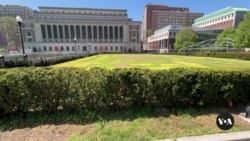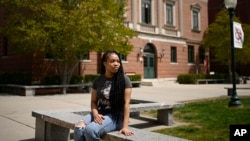Student Union
- By Robin Guess
US program seeks to resettle, educate refugee students

Many of the newest and youngest refugees are fleeing armed conflicts around the globe.
The world’s refugee crisis has never been worse. The number has doubled in a decade to more than 100 million people, according to the U.N. High Commissioner for Refugees.
To ease the growing crisis, the U.S. State Department launched a program in January 2023 with private partnerships, called Welcome Corps, to help resettle refugees. Six months later, it launched a companion version called Welcome Corps on Campus to resettle and educate refugee students by partnering with colleges and universities.
“Certainly, the Welcome Corps on Campus is not going to solve the global refugee crisis,” said Nele Feldmann, associate director, Welcome Corps on Campus, Community Sponsorship Hub.
“I think many times we feel powerless when confronted with the scope of displacement,” Feldmann said. “And I think that programs like Welcome Core on Campus give universities and colleges and their surrounding communities a really tangible way to have a positive impact and give back to refugee communities.”
Currently, Welcome Corps on Campus has recruited students who are in refuge in Jordan and Kenya for the incoming classes of 2024 and 2025. The students sheltered in Kenya were recruited from South Sudan, Somalia and the Democratic Republic of the Congo. And the students being sheltered in Jordan were largely recruited from Syria but include some Iraqi and Yemeni students.
As the program grows, the geographic scope of the recruitment efforts will include refugees from other parts of the world.
Two for JMU
James Madison University joined the new program and will sponsor two refugees.
The school handpicked a team of five sponsors who are tasked with providing care, support and guidance to two young Kenyans coming to their Virginia campus.
“This team is going to propel them so that their story doesn’t stop at James Madison; it is going to start here,” said Christina Kilby, a sponsor and a James Madison professor of religion.
“Only 5% or 6% of refugees get to access higher education,” she added.
The sponsors are anticipating and preparing for all of the details, big and small, their two African refugees will need to address to live in Harrisonburg, Virginia, along with the 22,000 other students on the JMU campus.
“What are those first interactions going to be like and what food are we going to bring?” said Kim Davidson, a sponsor, who is also the director of the Community Engagement Center at James Madison. “And where are we going to stop on the way home, and can we bring them a pillow?”
“What’s exciting to me is introducing them to my family,” Kilby told VOA. “And having my kids get to learn from them and their experiences, and that new network they are going to build to really make possible whatever their goals are."
Another member of the school’s refugees sponsor team is associate professor Delores Phillips, director of the African, African American and Diaspora Studies Center at JMU.
“I think I want to take them out myself and see what they like and see what they know,” Phillips told VOA. “And give them some time to acclimate. And let them wander around a little.”
Starting this fall
The program’s freshman class of 33 refugees, ages 18-24 and sheltered in Kenya, will start school, the first year of the program, in the fall of 2024 at 18 U.S. colleges and universities.
And the 75 members of the class that will start in the fall of 2025 were accepted and recruited while taking shelter in Jordan. If all goes as planned, the two incoming classes of freshmen will graduate from their schools in 2028 and 2029.
The State Department has resettled 138,134 of the world’s refugees into the U.S. since 2021. But Welcome Corps on Campus is a new path for resettlement into the U.S.
As part of Welcome Corps on Campus, the State Department granted the students in the program refugee status, humanitarian protection and asylum from the problems they are fleeing, such as violence or persecution based on their nationality, politics, religion, race or social affiliations.
One of the most important jobs the five sponsors will have is to protect the refugees from stereotypes and biases, Phillips said.
“I think that stigmas and assumptions are also going to be our challenge, in terms of an institution,” she said. “We will assume that they are poor. We will assume that they are unlettered and unread. We will assume that they are dusty village people and they may not be.”
Phillips added that, prior to being accepted into Welcome Corps on Campus, some of the refugees may have had outstanding educations that are equivalent to those received at Oxford University.
"They may have actually been schooled in the Oxonian tradition,” she added.
Survey results
Republicans and Democrats in Congress, President Joe Biden and former President Donald Trump are battling over immigration policy in the U.S. Currently, anti-immigration sentiments in the country are so high that many of the schools helping refugee students fear backlash, and they asked VOA not to identity their campuses.
A September 2022 Pew Research Center poll found 72% of Americans said it was very or somewhat important for the U.S. to take in civilian refugees seeking escape from violence and war, but only 28% of Americans said taking in refugees was a very important priority.
But JMU and its Welcome Corps on Campus sponsors are unwavering in their support for refugees, which some immigration experts and refugee advocates say sets an example for students and other schools.
“I just believe that we are all citizens of a very interconnected world,” said Davidson, of JMU’s Community Engagement Center. “They are leaving so much behind, like family and everything that they’ve known, and hopes and prayers. That’s a heavy weight on them and a responsibility on us, too.”
The sentiment all the sponsors share is that the Welcome Corps on Campus is good for refugees but also good for JMU because it is in line with the university’s mission to make a difference on a global scale by making a difference in the local community.
See all News Updates of the Day
- By VOA News
Amid internship pressure, international students should focus on self-care

That’s the argument of Edhita Singhal, an international student from India studying at the University of Southern California.
Despite the fear of not finding a good internship, it’s important to relax and take care of yourself, she writes in her biweekly column for campus newspaper The Daily Trojan. (April 2024)
- By Tina Trinh
Columbia students on edge as police presence remains on campus after raid to clear protesters
Police remain on Columbia University’s campus, even after clearing out student protesters and their encampment. But questions remain about how the university and the students move forward. Tina Trinh reports from New York.
Columbia University student journalists had an up-close view for days of drama
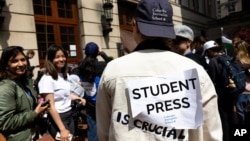
Student journalists on the Columbia University campus knew what was coming long before police with riot shields arrived to begin arresting the pro-Palestinian protesters.
They had watched the situation spiral as the protesters stood their ground, refusing to abandon Hamilton Hall and using a pulley system to bring supplies into the building they had occupied.
The reporters, working for university and online U.S. and international publications, suspected negotiations with administrators were going nowhere when the protesters began donning COVID-era masks to hide their identities. Some began sleeping on the floor in journalism classrooms or offices out of fear of missing something.
But when a journalism professor began writing the phone number to call if they were arrested in permanent marker on their arms, that was the moment it became clear: They were capturing history.
The police operation Tuesday night that cleared out Hamilton Hall capped two weeks of drama over the protests at Columbia, which student journalists at the Ivy League school lived through as they were covering it.
Other media were being kept off campus, so these reporters were the only ones who could capture what was happening.
"I just woke up and I was like, I'm going to go and take some pictures," said Seyma Bayram, a Columbia journalism fellow focused on creating a longform investigative podcast unrelated to the protests.
The encampments were a visual feast. There were musical performances, students reading and helping each other write papers for their classes. She wanted to document it all.
By Monday, students were facing suspension if they didn't leave. Crowds marched around the encampment chanting. Students were given written notices from the administration, warning them to go. They ripped them up, dumped them in trash bins. Rumors were flying.
That night, Bayram was unwilling to go home, sleeping on her office floor.
"How," she wondered, "are they going to remove the students. They're not leaving."
By Tuesday, she was exhausted. The student reporters charged their cameras and other gear and waited.
Many protesters were starting to leave, recalled Shayeza Walid, a graduate journalism student at Columbia, who covered the arrests for the news website Al-Monitor.
The sun was setting as they held hands and chanted, knowing they faced academic repercussions by remaining. Many had given up covering their faces by now, Walid said.
To her, the chants sounded like a hymn and she saw the protesters, some clad in Palestinian keffiyehs, crying. She doubts she will ever forget it.
"It felt so both inspirational and devastating because these were the kids who were willing to get arrested," she recalled.
And then police started assembling outside, setting up barricades. Even on campus, Bayram could tell by the photos posted on social media that police action was imminent. And then the police were there.
"I don't know, it was just like all of a sudden there were just like police, ... riot gear everywhere," Bayram said.
The student journalists were walking backward, filming as they went, Bayram said.
She was pushed off campus. Police buses and officers were everywhere. Around her, people were being arrested.
"Those of us who are pushed out, like student reporters and faculty, I think we were just all horrified that no press was present outside of, or inside of, Hamilton Hall," Bayram said.
Walid recalled that the reporters paired up for safety. Her partner, an international student, had never seen so many police in one place. "And frankly, I hadn't either," Walid said.
She said the police also seemed shocked when they came into campus and saw how few students were left. "It was very evidently disproportionate from where we were standing," she said.
Before the arrests, protesters inside the campus used a megaphone to lead those protesting outside in chants, recalled Cecilia Blotto, a graduate journalism student, who has been publishing photos and video to Uptown Radio, a project of the university's journalism program.
"Columbia, you are a liar," she recalled them chanting, along with "Disclose, divest! We will not stop, we will not rest."
Then Blotto saw police buses pull up, officers exiting with shields and zip ties. Then they played a recording saying that if the protesters didn't disperse they would be arrested.
"People were like being dragged out on the street, with like four cops holding a leg and an arm each. I saw some really, like, striking images of people, like, yelling shame at the cops, while they were dragging out students," Blotto said. She tried to film it all.
Emily Byrski, a graduate student who had a phone number written on her arm in case she was arrested, said the students weren't totally unprepared. There had been a training session.
Still, she said, there had been so many false alerts.
"It's like the boy who cried wolf. Like, there were two or three nights here where we were told, there was a rumor going around that the NYPD was coming, please come to campus," she recalled.
Byrski had knee surgery earlier in the year, so was unable to run as police descended. She limped along with her buddy.
"So we're sort of seeing this all happen from inside and trying to document it as the NYPD is grabbing people, like shoving them to the ground. It was pretty horrifying to see, like, right a foot away from me," Byrski said.
She said she has seen professors cry over the last week. She is pondering it all, uncertain what to make of it.
"I'm just sort of in shock," Byrski said. "I think we all kind of were in shock."
Botched US student aid application form rollout leaves many in limbo
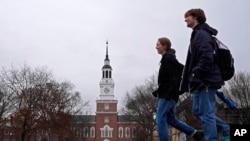
The last thing standing between Ashnaelle Bijoux and her college dream is the FAFSA form — a financial aid application that's supposed to help students go to college but is blocking her instead. She has tried to submit it over and over. Every time, it fails to go through.
"I feel overwhelmed and stressed out," said Bijoux, 19. She came close to tears the last time she tried the form. "I feel like I'm being held back."
Normally a time of celebration for high school seniors, this spring has been marred by the federal government's botched rollout of the new FAFSA application. By May 1, students usually know where they're headed to college in the fall. This year, most still haven't received financial aid offers. Three months before the start of fall classes, many don't know where they're going to college, or how they're going to pay for it.
"We're asking them to make probably one of the biggest financial decisions — and decisions that will have the biggest implications on their lives going forward — without all of the information," said Justin Draeger, president and CEO of the National Association of Student Financial Aid Administrators.
FAFSA, or Free Application for Federal Student Aid, went through a massive overhaul that was supposed to make it simpler and shorter. But a series of blunders by the Education Department made it harder than ever, delaying college decisions by months and raising fears that hundreds of thousands of students will forgo college entirely.
Across the United States, the number of students who have successfully submitted the FAFSA is down 29% from this time last year, and it's even worse at schools with more low-income students, according to the National College Attainment Network.
The group's CEO, Kim Cook, warned members of Congress this month about a potentially "catastrophic" drop in college enrollments that would make the decreases of the pandemic seem mild.
For Bijoux of Norwich, Connecticut, the FAFSA problems threaten to undermine the promise of higher education.
To her, college is a chance to seize the opportunities that weren't available to her mother, who immigrated from Haiti to the U.S. as an adult. Bijoux hopes to become a therapist and set a positive example for her three younger brothers.
If her FAFSA goes through, she should be eligible for enough financial aid to help with the $13,000-a-year tuition at Southern Connecticut State University. If not, she might go to a local community college, but even that would require loans if she can't complete the FAFSA.
"That's why it hurts, because it's like you work so hard to go somewhere and do something and make something of yourself," Bijoux said. "I thought I would start at a four-year (college) and then work hard continuously, like I've been doing basically my whole life. But that's not the case."
The updated FAFSA form has one section filled out by students and another by their parents. But when Bijoux finishes her part, nothing shows up on her mom's online account. She keeps trying, but nothing seems to change.
Similar problems have been reported across the country, along with numerous other bugs that the Education Department has scrambled to fix. Families who call for customer service have faced long wait times or say the call center hung up on them.
It "drains all the momentum" from families working to send their children to college, especially those navigating the process for the first time, said Anne Zinn, a counselor at Norwich Free Academy, where Bijoux goes to school.
"I can only say so many times, 'Just be patient, just be patient,' before they throw their hands up and they're like, 'Why am I doing this? I'm just going to go get a job,'" she said.
The rollout has attracted bipartisan criticism in Congress, and it's being investigated at the request of Republicans. Last week, Richard Cordray, the federal student loan chief who oversaw the FAFSA update, announced he's stepping down at the end of June.
For colleges, too, the delays pose a major threat.
Enrollment decreases like those being projected now could put many small colleges out of business or necessitate deep cuts in staff. Some colleges are pushing for emergency relief just to stay afloat, said Angel Pérez, CEO of the National Association for College Admission Counseling.
"If they don't get checks from the federal government to basically get them through next year, they will not survive," Pérez said.
FAFSA has been the linchpin of student financial aid for decades. It's used to determine eligibility for the federal Pell grant, a scholarship for low-income students, and it's required to receive federal student loans. Colleges and states also use FAFSA to distribute their own scholarships.
FAFSA had long been maligned for being tedious, difficult and intimidating to families without college experience. Congress passed legislation in 2020 meant to simplify the form. The Education Department was ordered to reduce the number of questions from more than 100 to about 40 and change the formula to expand aid to more students.
Problems started piling up as soon as the new form went online in December, already months overdue.
The first applications were incorrectly processed using an outdated calculation for inflation. Later, a federal contractor miscalculated a different formula on more than 200,000 applications. Each mistake added to delays, leaving students waiting longer to hear anything about financial aid.
Even more worrisome is a misstep that blocked students from finishing the form if they have a parent without a Social Security number. Advocates say the system locked out hundreds of thousands of students who are U.S. citizens or permanent residents but whose parents are not.
The Education Department on Tuesday said it's giving those parents a new way to enter their tax information manually. But as recently as this week, some students said they were still blocked from submitting the form.
Federal education officials say they're addressing lingering bugs but making progress. More than 8 million student applications have now been processed and sent to colleges, the agency said, and new applications are being processed within three days.
Still, the wait is far from over. It usually takes weeks for schools to prepare financial aid offers. Some colleges have extended decision deadlines to give students more time to weigh their options. But some stuck to May 1, forcing students to choose a college — and make a nonrefundable payment to hold their spot — without knowing all their scholarship options.
In Baltimore, Camryn Carter is waiting to find out if he'll get a full ride to the University of Maryland or face tens of thousands of dollars in student loans.
A top student and captain of his baseball and wrestling teams, Carter sees college as a step up in life. He thinks back to the times in the grocery store line when he had to put items back on the shelf because his mom couldn't afford the bill. A college degree would give him the stability he didn't always have, the 18-year-old said.
But when he looks at tuition, it's intimidating. Along with Maryland, he's also considering McDaniel College, a private school in Maryland. If he enrolls there, he expects to borrow almost $30,000 a year.
"I try to make the best decisions now so I can have a good future," he said. "I'm a little nervous that things won't work out. But I'm faithful."
- By VOA News
Florida program helps migrant students tutor younger children
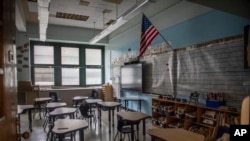
The 40-year-old initiative pairs migrant students in high school with elementary school children. High schools earn college scholarship money for their work. (April 2024)




